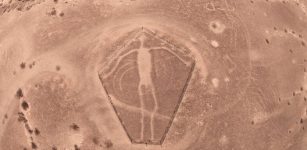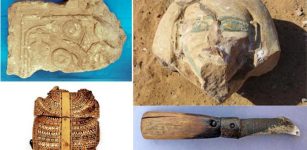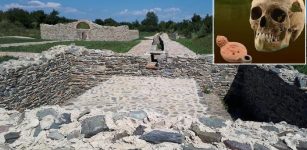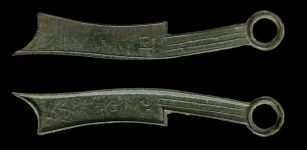Ancient Greeks Reached Iceland Before The Vikings – New Theory Suggests
Ellen Lloyd - AncientPages.com - The problem with researching Iceland's ancient history is the lack of written sources.
Most scholars say Iceland was discovered by Norse people who created the first settlement on the island around 870–930. The island was not populated until the Viking Age.
The oldest written document is the Íslendingabók (The Book of the Icelanders), written about 1130. Another interesting source dated to the 12th century is Landnámabók (The Book of Settlements).
The Icelandic Book of Settlements states Norwegian Ingólfr Arnarson was the first permanent settler who reached the island in 874. He built a home for himself and his wife, Hallveig Fródadóttir, at a site named Reykjavík. He worked as a farmer when more than 400 settlers sailed to Iceland with their families, servants, and enslaved people to claim part of the land. Most of the settlers came from Norway, but some came from other Nordic countries and the Norse Viking Age settlements in the British Isles.
Icelandic Sagas contain many fascinating stories about how sailors and settlers reached the island. However, these events are often associated with prophecies and supernatural powers making it hard to determine what did take place at the time.
For example, in Icelandic Sagas, we can read about many voyages to Iceland that "are purposeful, quasi-supernatural events, often guided by prophecies that are made before the settles even set off for Iceland." 1
One journey in the Vatnsdæla saga from 1300 A.D. focuses on Ingemund (Ingimundr Þorsteinsson), who fought for King Harald Fairhair of Norway at the Battle of Hafrsfjord.
More and more scholars have become interested in the possibility that ancient Greeks reached Iceland long before the Vikings and Norse people. This theory is based on the writings of Pytheas of Massilia (350 B.C. – 285 B.C.), who described his voyage to the Arctic and reported a strange land in the North today referred to as Thule.
"Pytheas was a Greek geographer, explorer, and astronomer. Today, he is considered the first known scientist who visited and described the Arctic, polar ice, and the Celtic and Germanic tribes. Being a good astronomer, Pytheas was also the first person to provide the world with a description of the Midnight Sun.
The accounts of Pytheas were for centuries discredited, but the idea of Thule captured the imagination of many who longed to learn more about this mysterious land in the North.
"Since classical times, Thule marked the imaginative horizon of the unknown North, first described by Pytheas of Massalia, who in the third century B.C. reported on a strange place far north ('six days sail north of Orcades') where the sun would never set in the summer and where the ocean was solid frozen. Nobody knows for sure how far north Pytheas went himself and how much he relied on secondary knowledge in his own (lost) descriptions of this place." 2
Pytheas stated Thule was inhabited by people whom he called the Hyperboreans. He also said they live on an island in the North of Britannia. It is a place "beyond the north wind." Later Greek and Roman authors such as Pliny, Pindar, and Herodotus described the Hyperboreans as happy people with exceptionally long lifespans and without illness.
The location of Thule has remained a mystery. Could Thule have been Shetlands Faroes, or was the island nothing but a myth?
Based on a new linguistic understanding of the Greek name, Andrew Breeze, an epigrapher at the University of Pamplona, argues the famous Thule was instead Iceland.
"While the name Thule has no meaning in Greek, Breeze suggests that it could be a scribal error for the original name Thymele, which means "altar" in ancient Greek. This name could perfectly fit the southern coast of Iceland." 3
Norsemen landing in Iceland. Painting by Oscar Wergeland (1909). Credit: Public Domain
According to Breeze, clues to the mystery can be found if we picture what Pytheas thought when he first saw Iceland.
In an article published by The Housman Society Journal, Breeze presents his theory arguing that "the dark volcanic cliffs of the south coast (above beaches of black sand) would have an altar's slab-like appearance; and the resemblance would be the more significant if mist and clouds rising from the island (to say nothing of plumes from its volcanoes, several in its southern part) reminded Pytheas of an altar's reeking sacrifices.
If he called the island 'altar, the altar' or thymele, no surprise.
Unfortunately, his wonder (and perhaps awe) on coming across land previously unknown was lost on his scribes. Hence, it seems, the corruption over three centuries from Thymele to Thoule and Thyle and Thule." 4
"Picturing Iceland as a giant altar also fits well with what we know of ancient Greek altars, according to Breeze. Many of these altars were incredibly large, with the one at Pergamum being 40 feet tall, and one at Syracuse was said to have been 600 feet long." 3
Breeze argues that "there can be no doubt that the place discovered by Pytheas was Iceland. An impressive achievement. Other candidates can be dismissed.
He called it Θυμέλη or Thymele' altar (island)' from its resemblance to a temple's sacrificial altar. Erroneous and meaningless 'Thule' can be dismissed as the result of scribal corruption. There is no justification for it, any more than for 'Boadicea' in Tacitus, a queen rightly called Boudica' victorious one, she who is triumphant.'
Nevertheless, anyone familiar with the ways of scholarship can be sure that, just as we still hear of 'Boadica,' so also we shall hear of 'Thule' for years to come. It will be one of the many scribal monsters which disfigure editions of classical texts, histories of the ancient world, and reference books published by famous universities." 4
The possibility ancient Greeks visited Iceland long before the Norsemen is fascinating, and equally are the linguistic arguments presented by Breeze. Unfortunately, no archaeological evidence supports this theory, but maybe one day, scientists will find something speaking in favor of this concept.
Written by - Ellen Lloyd AncientPages.com
Updated on January 14,2024
Copyright © AncientPages.com All rights reserved. This material may not be published, broadcast, rewritten or redistributed in whole or part without the express written permission of AncientPages.com
Expand for referencesReferences:
- Barraclough, E. R. (2012). Sailing the Saga Seas: Narrative, Cultural, and Geographical Perspectives in the North Atlantic Voyages of the Íslendingasögur. Journal of the North Atlantic, 18, 1–12.
- Hastrup, Kirsten. "Ultima Thule: Anthropology and the Call of the Unknown." The Journal of the Royal Anthropological Institute13, no. 4 (2007): 789-804.
- Nathan Steinmeyer - Who Discovered Iceland?, Biblical Archaeology
- Andrew Breeze, Thule and Juvenal xv 112 - The Housman Society Journal, Journal Vol.46, 2020
More From Ancient Pages
-
 Ancient Life-Size Marble Statue Of Hercules Discovered In Rome
Archaeology | Jan 28, 2023
Ancient Life-Size Marble Statue Of Hercules Discovered In Rome
Archaeology | Jan 28, 2023 -
 On This Day In History: Christiaan Huygens Discovers Saturn’s Largest Moon Titan – On Mar 25, 1655
News | Mar 25, 2017
On This Day In History: Christiaan Huygens Discovers Saturn’s Largest Moon Titan – On Mar 25, 1655
News | Mar 25, 2017 -
 Cryptic North American Blythe Intaglios Reveal The Creator Of Life: Who Was This Unknown Being?
Featured Stories | Aug 23, 2014
Cryptic North American Blythe Intaglios Reveal The Creator Of Life: Who Was This Unknown Being?
Featured Stories | Aug 23, 2014 -
 Collapse Of Akkadian Empire Strongly Related To Catastrophic Climate Change
Archaeology | Oct 28, 2019
Collapse Of Akkadian Empire Strongly Related To Catastrophic Climate Change
Archaeology | Oct 28, 2019 -
 Secrets Of Benjamin Franklin’s Paper Money Deciphered By Scientists
Archaeology | Jul 18, 2023
Secrets Of Benjamin Franklin’s Paper Money Deciphered By Scientists
Archaeology | Jul 18, 2023 -
 20 Mummies Discovered In Greco-Roman Tombs In Aswan, Egypt
Archaeology | Jan 21, 2022
20 Mummies Discovered In Greco-Roman Tombs In Aswan, Egypt
Archaeology | Jan 21, 2022 -
 Munkholmen: Island With Intriguing Yet Dark And Scary History
Featured Stories | Aug 25, 2023
Munkholmen: Island With Intriguing Yet Dark And Scary History
Featured Stories | Aug 25, 2023 -
 How Did Ancient Civilizations Make Sense Of The Cosmos And What Did They Get Right?
Civilizations | Mar 7, 2022
How Did Ancient Civilizations Make Sense Of The Cosmos And What Did They Get Right?
Civilizations | Mar 7, 2022 -
 Mysterious Object In Asuka – The Place Of ‘Flying Birds’
Civilizations | Aug 11, 2018
Mysterious Object In Asuka – The Place Of ‘Flying Birds’
Civilizations | Aug 11, 2018 -
 12,000-Year-Old Stones Found In Israel Could Be Earliest Evidence Of Wheel-Like Technology
Archaeology | Nov 13, 2024
12,000-Year-Old Stones Found In Israel Could Be Earliest Evidence Of Wheel-Like Technology
Archaeology | Nov 13, 2024 -
 Huge, Ancient Underground City Filled With Artifacts Discovered In Mardin, Turkey
Archaeology | Apr 20, 2022
Huge, Ancient Underground City Filled With Artifacts Discovered In Mardin, Turkey
Archaeology | Apr 20, 2022 -
 Treasure Of 1,753 Roman Silver Coins Accidentally Discovered In Poland
Archaeology | Apr 1, 2020
Treasure Of 1,753 Roman Silver Coins Accidentally Discovered In Poland
Archaeology | Apr 1, 2020 -
 Ancient DNA Analysis Shows How The Rise And Fall Of The Roman Empire Shifted Populations In The Balkans
DNA | Dec 8, 2023
Ancient DNA Analysis Shows How The Rise And Fall Of The Roman Empire Shifted Populations In The Balkans
DNA | Dec 8, 2023 -
 Scientists Decipher 2,300-Year-Old Chemistry Formulas Revealing Ancient Metallurgy Was More Complex Than Previosuly Thought
Ancient Technology | Aug 10, 2022
Scientists Decipher 2,300-Year-Old Chemistry Formulas Revealing Ancient Metallurgy Was More Complex Than Previosuly Thought
Ancient Technology | Aug 10, 2022 -
 Alexander Nevsky: Grand Prince Of Novgorod, Skilled Fighter, Quick–Thinking Strategist Who Defeated Swedish And German Invaders
Featured Stories | Feb 22, 2019
Alexander Nevsky: Grand Prince Of Novgorod, Skilled Fighter, Quick–Thinking Strategist Who Defeated Swedish And German Invaders
Featured Stories | Feb 22, 2019 -
 Chartres – Symbol Of Power And Secret Ancient Knowledge
Ancient Symbols | Nov 28, 2018
Chartres – Symbol Of Power And Secret Ancient Knowledge
Ancient Symbols | Nov 28, 2018 -
 Pacific God A’a: Fascinating Polynesian Sculpture Designed To Carry A Human Skull And Bones
Archaeology | Apr 9, 2016
Pacific God A’a: Fascinating Polynesian Sculpture Designed To Carry A Human Skull And Bones
Archaeology | Apr 9, 2016 -
 Dozens Of Unique 2,500-Year-Old Ceremonial Treasures Discovered In A Drained Peat Bog
Archaeology | Jan 27, 2023
Dozens Of Unique 2,500-Year-Old Ceremonial Treasures Discovered In A Drained Peat Bog
Archaeology | Jan 27, 2023 -
 Stone Age People Used Human Bones For Making Pendants
Archaeology | Jul 6, 2022
Stone Age People Used Human Bones For Making Pendants
Archaeology | Jul 6, 2022 -
 Mysterious Jade Cong – Perplexing Ancient Chinese Artifact
Featured Stories | Jan 3, 2023
Mysterious Jade Cong – Perplexing Ancient Chinese Artifact
Featured Stories | Jan 3, 2023



